By Jill Thayer, Ph.D., Contributing Writer, ARTPULSE Magazine, Miami, June, 2016
8 April – 25 June 2016, Canale Diaz Art Center, Coral Gables
“My work is precisely the result of that interaction between the artist and the medium with which he works, between the individual and the world that surrounds him. Through this gesture, I attempt to recount my personal story, presenting it as a discourse parallel to the recent history of humanity and enriching the creative act with symbolic and conceptual values that project it to a universal dimension.” [1] — Diego Santanelli
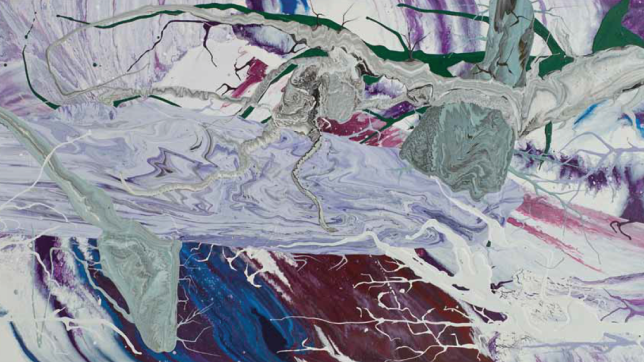
Diego Santanelli, Apocalypse zero.17MM, 2016, enamel on canvas, 80 x 40 inches. Photo: Antonio Vanni.
Resilience, Diego Santanelli’s solo exhibition at Canale Diaz Art Center, Coral Gables delves deep into the artist’s journey of self-discovery in an ambitious installation of work that is captivating and beguiling. In Apocalypse, a series of paintings that Santanelli has developed over the past four years, the medium is the message as he takes the constructs of abstract gestural painting to a metaphysical level. “Resilience” is the central theme in an act of renewal depicted in the work that reveals a personal quest in search of the divine, knowledge and truth, and the actualization of one’s inner self. Santanelli’s process of enlightenment is one of insight and revelation, as he tenaciously confronts the challenges of his own existence to seek harmony with the universe.
The Apocalypse of Saint John the Apostle or Book of Revelation includes themes of good versus evil and perseverance over adversity to ultimately render hope and triumph. The term “Apocalypse” is defined as a prophetic revelation–in Greek, it means ‘to lift the veil’ revealing the fate of humankind. These common narratives are further realized through an openness of perception beyond the material world to discover the truth that leads to emotional growth and reincarnation. This biblical tome sets the stage for Santanelli’s trilogy of expression in the creation of paintings, poems, and an opera that share this universal theme. His script for the mise en scène of a musical, Apocalypse Opera is based on the vision of Saint John the Apostle who engaged these concepts that are allegoric to Santanelli’s vision of life. His literary works draw from “fragments of emotional states,” that denote pain and hope referenced in the Apocalypse. The three enigmatic works are interconnected to embody a narrative of inquiry, as his poetry may segue to his paintings. Sacro Padre. Nuovo Mondo, Piango, Il Buco Bianco, Tra il bianco e il nero, and Catharsi for example, were created after the verse.
Santanelli notes, “Each artist functions as a kind of filter for the energy of the universe. Through him all energy passes, whether it be positive or negative. He metabolizes it and returns it to the universe in the form of works of art.”[2] His oeuvre has evolved through various genres and media including Expressionist figuration, mixed-media collage, thermosensitive enamels, and conceptual action painting, in which he currently engages a gravitationally driven technique. The medium serves as a mechanism to visually express the sublime, as it transforms personal adversity into optimism and resolve. The spontaneity of creation in levels of insight revealed offer purgation and spiritual renewal.
The sojourn metaphorically trekked on canvas references the meaning of life, its anguish, revelations, and eventual hope of eternity in the afterlife. Santanelli asserts that the Apocalypse “is a complex journey that is perfected upon arriving at Celestial Jerusalem, a place of light and revelation, the perfect city for man in an eternal alliance with God.”[3] In his works, this context is presented through pictorial experimentation that Santanelli bases on free interaction with the material as he employs new perspectives to seek a deeper meaning of his work and articulation of it. This is evident in the intricacies and multi-faceted levels of his application that suggests a catharsis between his inner self and the real world.
Santanelli devised a method that he refers to as ‘branching,’ created by aggressively spilling paint over the canvas surface and letting gravity take its shape. This allows the viscous medium to form, dispense, and coalesce into its final state. ‘Branching’ signifies the wayward souls that “solemnly pass through the door to the underworld, suspended in the eternal dichotomy between good and evil, between black and white,” Santanelli notes. The consequences of the paint’s actions crystalize an impassioned plight in a journey of self-awareness.
The viewer may interpret the compositional forms as intentional objects, however they are the result of a free flow of the medium. This respect of the natural order brings layers of translucency, opacity, and meaning to the message. The trajectory parallels the energy of the physical, psychological, and universal forces that are part of one’s growth and reflection.
The revolutionary methodologies of action painters such as Jackson Pollack, Arshile Gorky, Franz Kline, and Willem de Kooning were precursors of this genre. Harold Rodenberg who coined the term, “Action Painting,” aligned the creative act as a reflection of the artist’s life. He likened the “gesture on canvas,” to “a gesture of liberation, from Value—political, aesthetic, moral.”[4] Santanelli shares a connection to Pollack in visualizing the potential of his process, albeit subconsciously, that may have inspired his ‘branching’ technique in the semiology of his work. As Pollack’s approach may be perceived as organic or representing the essence of a chaotic new world, Santanelli distinguishes “chaos” as the force that governs earthly and unearthly worlds. He sees his work reflecting an exploration of inner self, replete with the trials and tribulations of life that are visually acknowledged and resolved in his compositions.
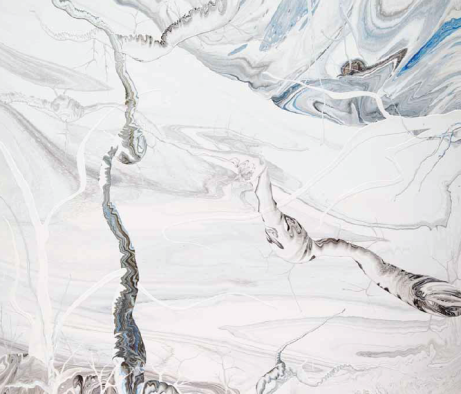
Diego Santanelli, Apocalypse zero.20M, 2016, enamel on canvas, 60 x 70 inches. Photo: Antonio Vanni.
Apocalypse zero.20M, 2016 features two dominate formations that represent souls suspended and animated with energy. The forms resemble funnel clouds twisting and turning in the angst of a storm. Marbleized patterns in a sky of grays and blues swirl within the currents in search of respite. One of the forms extends diagonally from the right towards the center of the composition appearing to touch the other much like Michelangelo’s “Creation of Adam.” The touch of life quells nature’s wrath tethered within the painting’s boundaries.
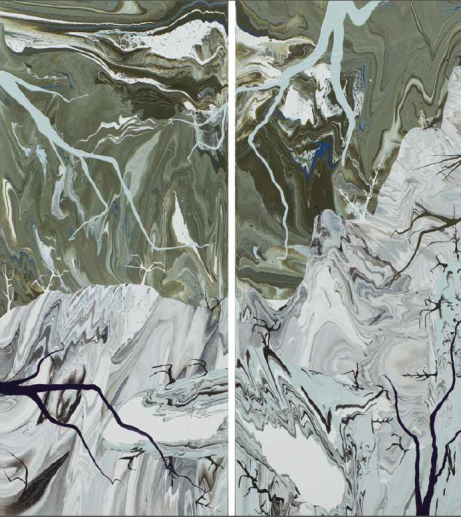
Diego Santanelli, Apocalypse zero.10M, 2016, enamel
on canvas, 70 x 30 inches (each). Photo: Antonio Vanni.
For Diego Santanelli, his enamel pigments ebb and flow on the canvas surface like tributaries to a river. Harmonies of color pose veiled constructs that lend fluidity and structure to an apocalyptic course. The challenges of life’s ups and downs are reflected in the lucid meanderings of his media, organic yet controlled on the paintings’ edge; transforming darkness into light, pain into empowerment, and evil into good. Aesthetic and literary forces align in a complex web on the labyrinth of life to comfort and guide beleaguered souls. Santanelli’s voyage is articulate, tenacious, and keen, as his innovative mastery tells the story.
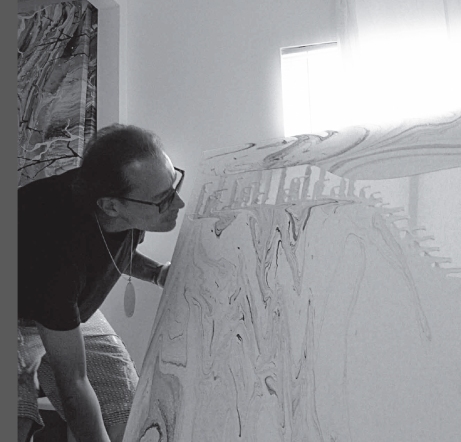
Diego Santanelli in the studio
________
[1] Fragment of the declaration of the artist.
[2] “Diego Santanelli: Resilience,” Interview by Raisa Clavico. Diego Santanelli Catalogue, Canale Diaz Art Publications. (2016).
[3] Ibid.
[4] MacAdam, Barbara A. ‘Top Ten ARTnews Stories: ‘Not a Picture but an Event,’” ©2016 ARTnews Ltd. (2016). Retrieved from http://www.artnews.com/2007/11/01/top-ten-artnews-stories-not-a-picture-but-an-event/
Jill Thayer, Ph.D. is an artist, educator, art historian, and a curatorial archivist. She is Associate Professor at Santa Monica College in Art History: Global Visual Culture; and Allan Hancock College, and South University, Savanna in Art History; She is Associate Faculty at Post University Malcolm Baldrige School of Business MBA Program in Integrative Media Strategies. Her oral history narratives of contemporary artists are included in Archives of American Art at the Smithsonian Institution.

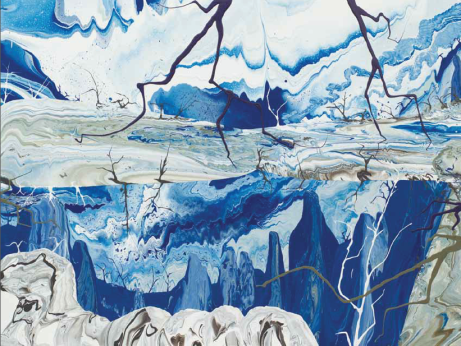
You must be logged in to post a comment.